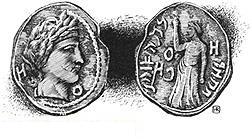
Aretas IV Philopatris
Encyclopedia

Rulers of Nabatea
The Rulers of Nabataea, reigned over the Nabataean kingdom , inhabited by the Nabateans, located in present-day Jordan, southern Syria, southern Israel and north-western Saudi Arabia.- List :...
from roughly 9 BC to AD 40.
His full title, as given in the inscriptions, was "Aretas, King of the Nabataeans, Friend of his People." Being the most powerful neighbour of Judea
Judea
Judea or Judæa was the name of the mountainous southern part of the historic Land of Israel from the 8th century BCE to the 2nd century CE, when Roman Judea was renamed Syria Palaestina following the Jewish Bar Kokhba revolt.-Etymology:The...
, he frequently took part in the state affairs of that country, and was influential in shaping the destiny of its rulers. While on not particularly good terms with Rome
Rome
Rome is the capital of Italy and the country's largest and most populated city and comune, with over 2.7 million residents in . The city is located in the central-western portion of the Italian Peninsula, on the Tiber River within the Lazio region of Italy.Rome's history spans two and a half...
- as intimated by his surname, "Friend of his People", which is in direct opposition to the prevalent φιλορώμαις ("Friend of the Romans") and φιλόκαισαρ ("Friend of the Emperor") - and though it was only after great hesitation that Augustus
Augustus
Augustus ;23 September 63 BC – 19 August AD 14) is considered the first emperor of the Roman Empire, which he ruled alone from 27 BC until his death in 14 AD.The dates of his rule are contemporary dates; Augustus lived under two calendars, the Roman Republican until 45 BC, and the Julian...
recognized him as king, nevertheless he took part in the expedition of Varus
Varus
-People:*Publius Attius Varus , Roman governor of Africa.*Publius Quinctilius Varus , politician of the Roman Empire.*Quinctilius Varus -People:*Publius Attius Varus (died 17 March 45 BCE), Roman governor of Africa.*Publius Quinctilius Varus (46 BCE - 9 CE), politician of the Roman...
against the Jews in the year 4 BC, and placed a considerable army at the disposal of the Roman general.
His daughter Phasaelis married Herod Antipas
Herod Antipas
Herod Antipater , known by the nickname Antipas, was a 1st-century AD ruler of Galilee and Perea, who bore the title of tetrarch...
, otherwise known as Herod the Tetrarch. When Herod divorced Phasaelis to take his brother's wife Herodias
Herodias
Herodias was a Jewish princess of the Herodian Dynasty. Asteroid 546 Herodias is named after her.-Family relationships:*Daughter of Aristobulus IV...
, mother of Salome
Salome
Salome , the Daughter of Herodias , is known from the New Testament...
, in AD 26, Phasaelis fled to her father. Aretas IV invaded Herod's holdings, defeating his army and capturing territories along the West Bank
West Bank
The West Bank ) of the Jordan River is the landlocked geographical eastern part of the Palestinian territories located in Western Asia. To the west, north, and south, the West Bank shares borders with the state of Israel. To the east, across the Jordan River, lies the Hashemite Kingdom of Jordan...
of the Jordan River, including the areas around Qumran
Qumran
Qumran is an archaeological site in the West Bank. It is located on a dry plateau about a mile inland from the northwestern shore of the Dead Sea, near the Israeli settlement and kibbutz of Kalia...
.
The classical author Josephus
Josephus
Titus Flavius Josephus , also called Joseph ben Matityahu , was a 1st-century Romano-Jewish historian and hagiographer of priestly and royal ancestry who recorded Jewish history, with special emphasis on the 1st century AD and the First Jewish–Roman War, which resulted in the Destruction of...
connects this battle, which occurred during the winter of AD 26/27, with the beheading of John the Baptist
John the Baptist
John the Baptist was an itinerant preacher and a major religious figure mentioned in the Canonical gospels. He is described in the Gospel of Luke as a relative of Jesus, who led a movement of baptism at the Jordan River...
, but not necessarily occurring at the same time.
Herod Antipas
Herod Antipas
Herod Antipater , known by the nickname Antipas, was a 1st-century AD ruler of Galilee and Perea, who bore the title of tetrarch...
then appealed to Emperor Tiberius
Tiberius
Tiberius , was Roman Emperor from 14 AD to 37 AD. Tiberius was by birth a Claudian, son of Tiberius Claudius Nero and Livia Drusilla. His mother divorced Nero and married Augustus in 39 BC, making him a step-son of Octavian...
, who dispatched the governor of Syria to attack Aretas. But because of the emperor's death in AD 37 this action was never carried out.http://jewishencyclopedia.com/view.jsp?artid=1752&letter=A&search=Aretas
The Christian Apostle, Paul, mentions that he had to sneak out of Damascus in a basket through a window in the wall to escape the Governor (ethnarch) of King Aretas. (2 Corinthians
Second Epistle to the Corinthians
The second epistle of Paul the apostle to the Corinthians, often referred to as Second Corinthians , is the eighth book of the New Testament of the Bible...
11:32, 33, cf Acts
Acts of the Apostles
The Acts of the Apostles , usually referred to simply as Acts, is the fifth book of the New Testament; Acts outlines the history of the Apostolic Age...
9:23, 24), The question remains open as to when King Aretas received Damascus from Caligula in the imperial settlement of the affairs of Syria. The Aretas’ administration in Damascus may have begun as early as CE 37 based upon archeological evidence in the form of a Damascus coin, with the image of King Aretas and the date 101. If that date points to the Pompian era, it equals C.E. 37 (T. E. Mionnet, Description des medailles antiques greques et romaines, V [1811], 284f.)

